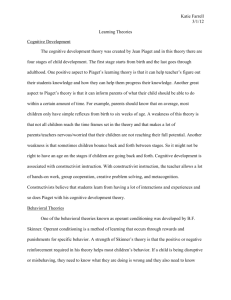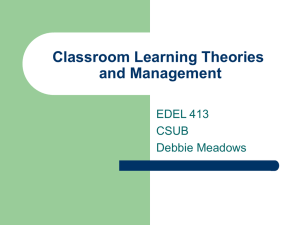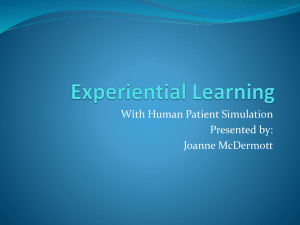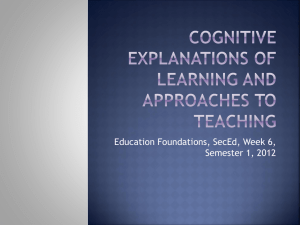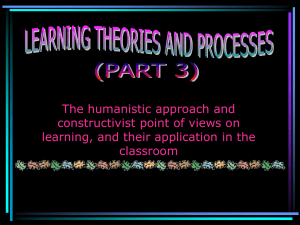View Humanistic Constructivism - The Website of Ethan Thomas
advertisement
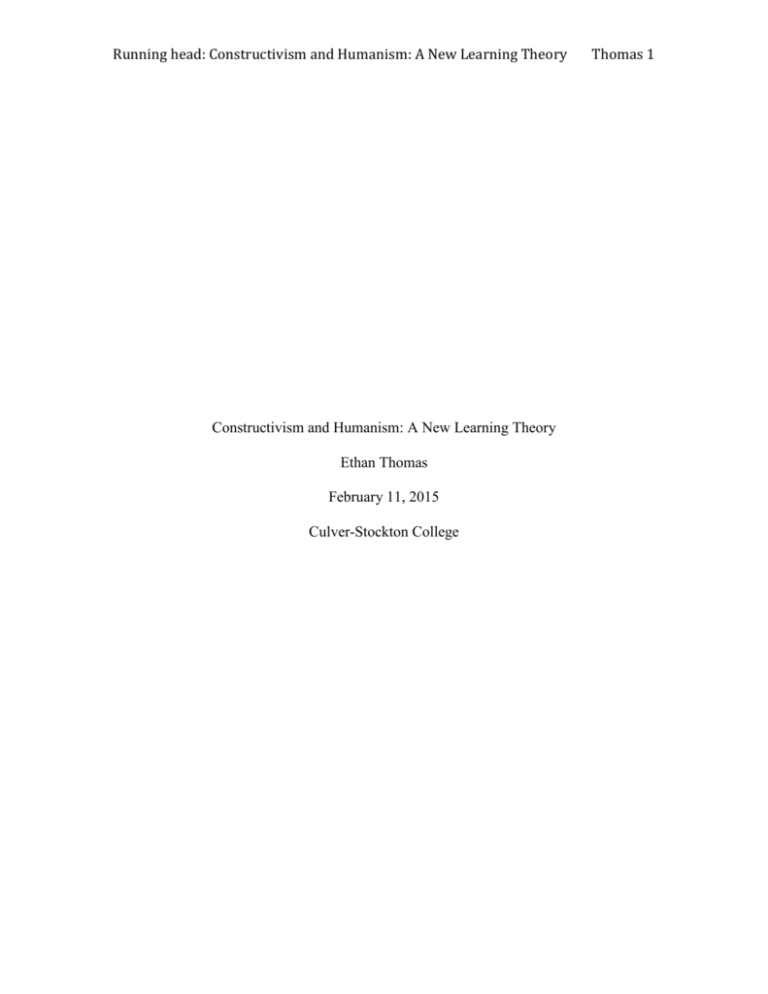
Running head: Constructivism and Humanism: A New Learning Theory Constructivism and Humanism: A New Learning Theory Ethan Thomas February 11, 2015 Culver-Stockton College Thomas 1 Constructivism and Humanism: A New Learning Theory Thomas 2 As I read through the different types of learning theories in Shelly and Gunter’s Instructional Tech book, I came across different ideas and theories that I somewhat agreed with. The cognitivist theory has a few ideas that I could see clearly and Robert Gagne’s “9 Events of Instruction” would be a very useful tool in the classroom despite it being initially made for the military. What definitely caught my attention, however, was the constructivist theory – more importantly Lev Vygotsky Jerome Bruner’s (b. 1915) view of constructivism. Their views that the most successful learners are actively engaged in the learning process and learn by participation struck a chord in me. Their personal theories combined with Maslow’s theory of humanism – which is the idea that humans “strive, within their own personal limitations, to achieve the maximum personal growth (Gould, 2010)” - captures my own personal idea of how education should be. In order to agree with constructivism, I first have to know what the theory is as well as what it stands for. Constructivism, being one of the four major learning theories, which are the cognitive theory, the experiential learning theory, and the behaviorist theory; is the belief that learners build their own set of content to solve a particular set of problems posed by the instructor (Leonard, 2002). Constructivist learners learn in a group setting, collaborating with others to get the best efficiency of learning possible. This learning theory would be most effective, in my opinion, in a band setting. In band, students have to work together to achieve the best possible sound out of the group as a whole, not separately. Without each other, the constructivist learning of the entire group is stifled and delayed. In constructivism, the instructor would become a catalyst or just a mediator of the information to be used freely by the students to achieve learning in their own way, not a Constructivism and Humanism: A New Learning Theory Thomas 3 gate or wall that releases clusters of information that each individual must learn uniformly. Jerome Bruner’s personal theory within constructivism was that learners learn based on what they have experienced in their past, and that learners use past knowledge to build upon while learning something new. His theory would work very well within my classroom, where students would be constantly learning new music and forming new music ideas. Students in my band class would have to base all of their new knowledge off of previous knowledge on music or they simply would not learn. As an example, in order for the lead alto saxophone player to correctly play the intro to “Fantasia on the Dargason” to the best of his musical abilities, he would first have to know what notes to use, how to play those notes on the alto saxophone, how rhythms work, how to articulate those rhythms correctly, and many more instructions; which, in turn, would need to be unlocked by learning other skills like how to make any sound out of the alto saxophone and hold it correctly to get the best sound. All of these skills interweave with each other to unlock new abilities and knowledge, which the alto saxophone player uses to perform the intro to Holst’s “Fantasia on the Dargason”. Lev Vygotsky’s personal constructivist theory was that learners’ ability to learn was impacted – both positively and negatively – by their social development (Shelly, 2012). He called his idea social cognition. If a child was raised in a horrible social condition, the child’s ability to learn would be severely impacted in the negative way; while if the child was raised in a positive social environment, the child’s learning would be positively impacted. Vygotsky personally abhorred the behaviorist learning theory that humans could learn efficiently through conditioning and all but scolded Pavlov and Bekhterev in his post-doctorate book The Methodology of Reflexology and Psychological Constructivism and Humanism: A New Learning Theory Thomas 4 Studies (Pass, 2004), which lets me agree with him further due to my bias against the use of classical conditioning alone in the classroom. Constructivism is one of the main learning theories and would fit well with me in my classroom because of the participatory learning, but the theory by itself is incomplete. When paired with the theory of humanism, however, I could create my own theory that I would be able to effectively use in the classroom to great success. Abraham Maslow’s personal view on humanism would be what I would choose to incorporate into my own learning theory. Maslow’s most known work is his “hierarchy of needs”, which was the idea that you would need physiological fulfillment (heat and light) before you could achieve physical and psychological safety; and that you would need that before you could achieve belonging; and that you would need belonging before you could achieve esteem; and esteem before you could achieve self-actualization. Maslow’s work draws near the cognitive learning theory, which would be why many cognitivists claim Maslow as their own. Maslow as well as Carl Rogers believed that behaviorism “took an overly pessimistic view of the human condition” (Gould, 2010) and were also against the idea that humans could all learn the same way. Humanism describes humans’ ability to learn as “stressing individuality or uniqueness of the person” (Gould, 2010). The main goal of humanism is to assist people in maximizing their potential for potential growth. This theory, when combined with constructivism would be the perfect theory for my classroom and students because while the students, in the band setting, would use participatory and collaborative learning to achieve the greatest band sound that they can make, and the students would use prior knowledge to build new knowledge upon; I Constructivism and Humanism: A New Learning Theory Thomas 5 would also know that the students are all unique and individual in their own way and learn differently than everybody else. The constructivist and humanism theories together, I would name the humanistic constructivist theory. This new theory will aid me in the classroom as well as the students because in the music setting, students are surrounded by sounds and music. Band is among the most collaborative and hands-on subjects in the standard school and constantly uses teamwork and group learning to lead to success. Treating every student the same way like I would if I had chose the behaviorist theory would only lead to failure because each student is unique. Every student learns in a slightly different way, and the humanistic side to my new theory accounts for that completely. “Vygotsky believed that students should work collaboratively to share their different perspectives with each other. (Shelly 2012)” In the music setting different perspectives could mean multiple different things. It could mean different views and perspectives from other students in the classroom on how a certain section of the music should go, or it can mean a perspective from an entirely different college, university, or school on how a piece of music should sound through the use of a recording. For example, Culver-Stockton College’s wind ensemble has a very decent sound to play a wide repertoire of music, but the Eastman University’s wind ensemble might have a different sound altogether, which would enable it to play a different repertoire of music, some of which would cross into ours. The Eastman wind ensemble might have a different idea how a certain piece should sound than the CulverStockton wind ensemble. This is among the wider spectrum of differing ideas of sound. The closer spectrum would be different students of the C-SC wind ensemble having Constructivism and Humanism: A New Learning Theory Thomas 6 different ideas of how a certain piece should sound, both being based on prior knowledge of the piece or other pieces that compare to it. The main ideas of the humanistic constructivist would take the main ideas of constructivism - which “emphasized the importance of the interface between individual and experience (Constructivist Foundations, 2014)” – and combine it with the humanism theory’s main idea that all humans strive to achieve maximum or personal growth with their own limitations. The combined main idea would be this: people learn the most efficiently through collaboration and group-participatory learning to achieve maximum or personal growth while being affected by their own individual limitations, experiences, and knowledge. Constructivism and Humanism: A New Learning Theory Thomas 7 Bibliography Bowers, J., Gruver., & Trang, V. (2014). Radical Constructivism: A Theory of Individual and Collective Change?.Constructivist Foundations, 9(3), 310-312. Pass, S. (2004). Parrallel Paths to Constructivism: Jean Piaget and Lev Vygotsky. Greenwich, Conn: Information Age Publishing. Leonard, D. C. (2002). Learning Theories, A to Z. Westport, Conn: Oryz Press. Gould, J. (2010). Learning Theory and Classroom Practice in the Lifelong Learning Sector. Exeter: Learning Matters Ltd. Shelly, G., & Gunter, G. (2012). Technology, Digital Media, and Curriculum Integration. In Teachers discovering computers: Integrating technology in a connected world (Seventh ed., pp. 257-280). Boston, MA: Cengage Learning.



